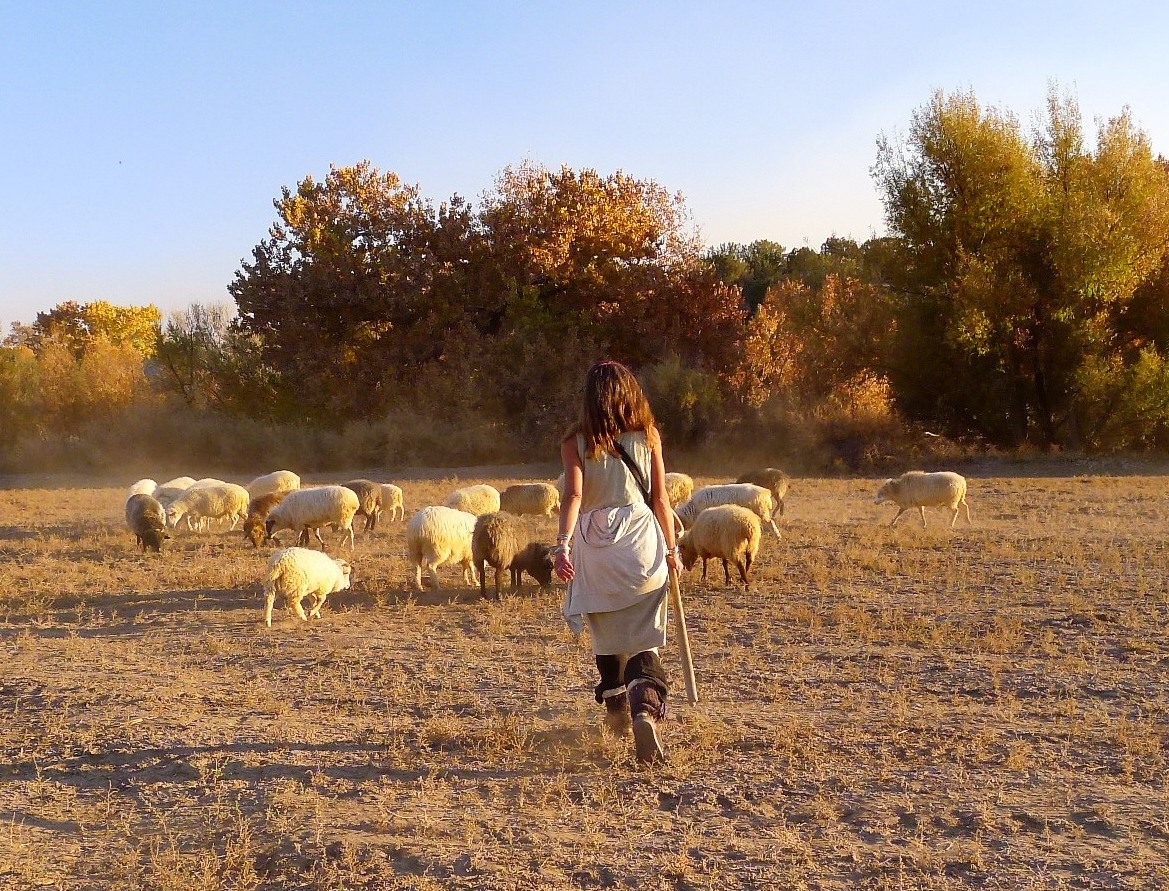A modern-day shepherdess and her flock defy stereotypes

It’s like a charming scene from an old engraving, a storybook illustration of Little Bo Peep: Amata Bocella is herding her flock across a field at El Rancho de las Golondrinas in Cienaga. Her long skirts trailing over fast-striding boots, she holds large wooden staffs and sings to the sheep, who all come running after her.
This being Santa Fe in 2012, however, Bocella turns out to be no blushing damsel. A whip-smart college girl and latter-day hippie from Pittsburgh, she is passionate in defense of her ruminants, relating the story of how she came to save them and, more to the point, how they came to save her.
El Rancho de las Golondrinas is a “living history” museum dating from the early 1700s, where costumed villagers grind flour, shoe horses, and weave with fleece from on-site Navajo-churro sheep. In keeping with its traditional workings, the ranch each spring used to cull the male lambs and gift them to villagers as Easter dinner entrees.
That didn’t quite cut it with their modern-day shepherdess, who arrived at las Golondrinas in 2000 as an animal rescuer and vegan. A psychology major from Carnegie-Mellon University, Bocella had met her destiny when a car crash left her with a traumatic brain injury. She came to New Mexico to pursue an interest in natural healing. While rehabilitating and working as a massage therapist and veterinary assistant, she decided to volunteer at El Rancho de las Golondrinas.
“The first month I was here, someone ran in and said a lamb had been born sick and the mother ditched it,” she recalls. “Before I knew what I was doing, I put it in my car and took it to the vet.” She named the babe Lambina, and everywhere she went, the lamb was sure to go. “She would ride shotgun in my Isuzu Sidekick. It was quite a sight. Lambina thought she was a dog, because she was raised by dogs” — including Bocella’s black Lab, Stella. But when the time came to reintroduce the sheep to her flock, the fleecy family would have none of it.
“They were terrified of humans,” Bocella says. “They had never left the corral.” For days and months on end, she would bring Lambina and just sit in a corner, waiting for a female to approach. Finally, after nearly a year, one came and took a carrot from her hand. And that was the start.
Bocella convinced the ranch to let her take the sheep out to pasture occasionally. Then she worked on getting them to give her the “culls,” animals whose fleece was no longer useful and were destined for slaughter. In 2003 she created Sheep Sanctuary Inc. to care for those unwanted sheep (and now goats and horses too), as a kind of retirement home for ruminants that now numbers 53 animals.

Meanwhile, the flock at las Golondrinas imprinted mightily on its beloved shepherdess. As soon as she slams the door of her Prius, their bleating can be heard from the corral where they once lived out their whole lives. Following her to the fields like newborn chicks, the sheep serve as Bocella’s vindication, proof of how enlightened animals can be in their natural state.
“They are naturally intelligent, but they act ‘like sheep’ because they’ve been frightened their whole lives,” she explains. “Most farm animals live in a state of PTSD.”
Like the celebrated animal advocate Temple Grandin, whose autism gave her a special sensitivity to cattle, Bocella seems to empathize deeply with the sheep’s vulnerability and trauma. For years she has battled an acute chemical sensitivity brought on by her injury and a toxic apartment building. A few years ago she got a service dog through Assistance Dogs of the West, for days when a whiff of laundry detergent sends her staggering from toxic encephelopathy.
Living in a modern minefield of airborne poisons, Bocella takes solace with her flock toward dusk, after the ranch has closed. She leads them across the fields, singing. “I just kind of go deep with the sheep,” she says. “They communicate a lot with me. I’ve been documenting it with video because people never see what happens when it’s just me and them. When they’re in public, they ‘play sheep’ and keep their heads down.”
Not today, however, when several animals approach with an expectant attention one associates with dogs.
Bocella reads them, too, as most humans cannot. “Did you see that?” she’ll blurt out. “Did you see what Miss June just did?” Within their family groups, certain sheep have jobs, she says — like the one who makes sure the whole group is together. Sure enough, as we follow the flock across a bridge, a lone sheep looks back and bleats to indicate the loner lagging behind us.
A braying in the distance sends the shepherdess running up the path with her staff. “I’m coming! What is it? Where’s your mom?” Her ears tuned in, Bocella seems to know which bleats signify nervousness or impatience, who’s saying what to whom.
Sheep have feelings, memories, and grieve deeply when their lambs are taken away, Bocella says. They can learn commands. “The biblical metaphor of the good shepherd is true—I reflect on it often,” she says. “A good shepherd knows them by name, and the sheep know him. But not all have been good shepherds.” Her flock became socialized “only after several generations of seeing that their babies were not being taken away, their siblings not being slaughtered in front of them. They’re in a safe environment.”

Now proud to be known as “no-kill,” El Rancho de las Golondrinas has embraced Bocella’s role, a far cry from the days when she fought to turn back centuries- old tradition. Though she can’t stop the horrors of factory farming, or the slaughter of millions of sheep in the name of religion, in this corner of the world at least, the ranch gives her a vehicle to teach children awareness and respect for animals.
She sees it as a return to tradition, not a departure. “It was actually the women — Diné slaves — who were the pastoras” in colonial New Spain, she says.
The Sheep Sanctuary is looking for volunteers. Contact 505-424-4290 or sheepsanctuary@msn.com.
